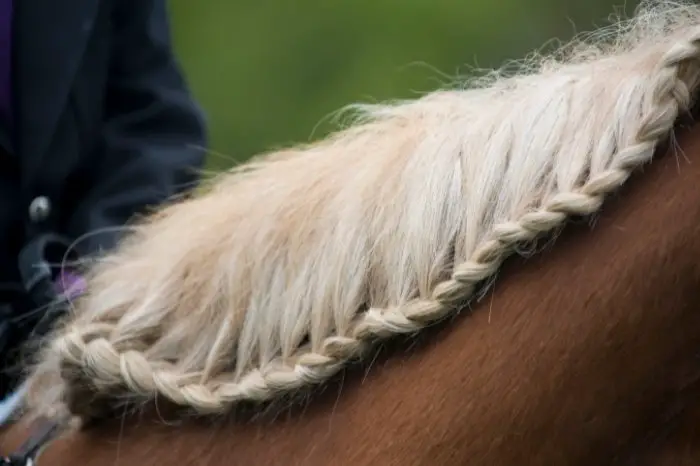Last Updated on February 1, 2022
The running braid mane is a simple and effective way to keep a long and unruly mane under control. Whether you’re making your horse look his best for the show ring, or want to keep him cool on a hot day, running braids on horses are easy to learn and look amazing too!
Let’s find out more about how to do a running braid mane on your horse.
Why Use A Running Braid On Your Horse?
Traditionally, horses have been braided for many years. As with most things, braiding started for practical reasons, but then evolved into something done to improve the appearance of the horse. Braiding can be done on both the tail and the mane of a horse, including the forelock.
Braiding is useful as it keeps long hair tidy and under control. This prevents it from getting tangled up in tack or equipment – particularly useful for working horses on the farm or ranch.

Braiding also keeps the mane hair off the neck of the horse. Many horses will sweat in warm weather, particularly if they have a heavy mane lying on the neck. A braid will help to keep the neck cool and free from sweat.
If you are trying to grow your horse’s mane, then braiding can also help to prevent tangling and breakage of the hairs.
How To Do A Running Braid Mane
To create a beautiful running braid mane, firstly you need to prepare the mane. It should be well-combed and free from tangles. If the mane is in poor condition, you might find it beneficial to wash and condition it first.
It is far easier to do a running braid mane on hair that is damp or wet. If you have not washed the hair, then damp it down with a sponge or brush after combing.
Start your running braid plait at the poll of the horse, just behind the horse’s ears. Take a section of hair approximately two inches long and divide this into three sections.
Use these three sections to start a standard three-strand braid. As you cross the hair section closest to the crest into the middle of the braid, add another section of hair from the mane to the braid.
Now, how closely you follow the top of the neck as your braid is entirely down to personal preference. A shorter mane will need to be plaited close to the crest, whereas longer manes can run along the side of the neck.
Continue plaiting in this way until you reach the end of the mane. When there is no more mane to add to the braid, continue a regular three-strand plait to the end of the hair. Secure the end of the plait with an elastic band or yarn.
As with most practical skills, the best way to learn how to do a running braid mane is by watching a demonstration. Then you will need to practice, practice, practice until you’ve got it perfect. Luckily, running a braid is one of the easier types of the plait to learn, and you should have your horse beautifully turned out in no time.
Click Here to Learn About:
How To Fasten Running Braids On Horses
Most people use elastic bands to secure braids on horses, but yarn can also be very effective.
Elastic bands are used around the end of the plait. It is common practice to use one band at the end of the plait, then fold the loose hairs under the plait into a bun. This is then secured in place with a second elastic band.
Yarn is used in a similar way, but the same piece of yarn can be used to secure both the end of the braid and the bun. This will normally stay firmly in place for longer than an elastic band.
Running Braid Mane Summary
So, as we have learned, a running braid mane on a horse is a single plait that runs down the neck, incorporating sections of the mane as it goes. This is a great way to keep a long mane under control and also prevent sweat from building up under the mane. The running braid plait can either sit tightly on the crest of the horse or if the mane is longer it can run along the side of the neck.
We’d love to hear your thoughts on running braids on horses! Is this your favorite type of braid for your horse? Or maybe you’ve struggled to get a neat running braid on your horse? Leave a comment below and we’ll get back to you!
FAQs

Kate Chalmers is a qualified veterinary nurse who has specialized in horse care for the vast majority of her career. She has been around horses since she was a child, starting out riding ponies and helping out at the local stables before going on to college to study Horse Care & Management. She has backed and trained many horses during her lifetime and competed in various equestrian sports at different levels.
After Kate qualified as a veterinary nurse, she provided nursing care to the patients of a large equine veterinary hospital for many years. She then went on to teach horse care and veterinary nursing at one of the top colleges in the country. This has led to an in-depth knowledge of the care needs of horses and their various medical ailments, as well as a life-long passion for educating horse owners on how to provide the best possible care for their four-legged friends.
Kate Chalmers BSc (Hons) CVN, Dip AVN (Equine) Dip HE CVN EVN VN A1 PGCE

